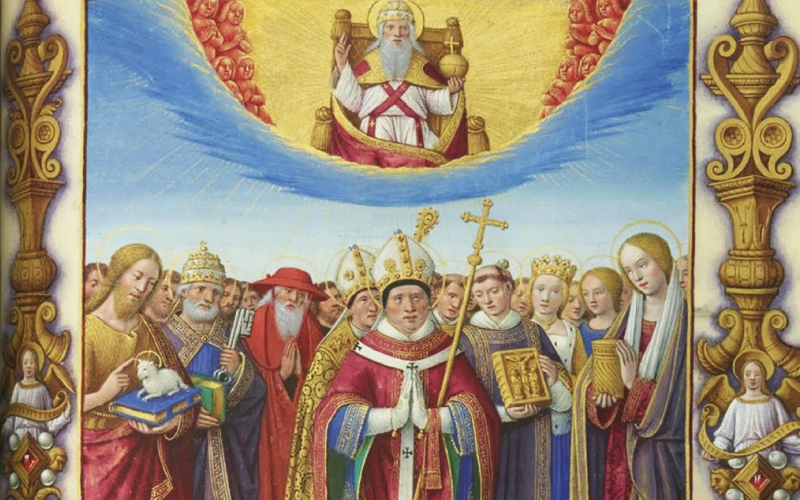There is no greater prayer in the world than the Holy Sacrifice of the Mass.
And there can be no greater earthly honor to a saint than to be mentioned in the Canon of the Mass during which the bread and wine are transubstantiated into the Body, Blood, Soul, and Divinity of Jesus Christ and offered to God the Father in sacrifice. As the Council of Trent has affirmed, the Mass is the “true and proper sacrifice.” The priest not only offers the Sacrifice of Jesus truly present, but the priest acts in the person of Christ (in persona Christi). Therefore, when the priest pronounces the words of Consecration, it is not just the priest speaking but rather Jesus speaking through the priest.
In the Canon of the Mass, the Eucharistic Lord is offered to the Father. For the Sacrifice of the Mass is truly the same Sacrifice of the Cross. It is not a new or different sacrifice. The Canon involves numerous holy prayers, each with great theological importance. There are nine occasions on which the Sign of the Cross is made, each symbolic of the Passion of Our Lord Jesus Christ.
The Saints of the Roman Canon Mentioned Before the Consecration
In the Canon of the Mass there are two groups of saints mentioned – the first group is mentioned before the Consecration and the second group after the Consecration. The first group lists 26 saints.
“In union with and venerating the memory of, in the first place, the glorious ever Virgin Mary, Mother of God and our Lord Jesus Christ, but also blessed Joseph, spouse of the same Virgin, and your blessed Apostles and Martyrs, Peter and Paul, Andrew, James and John, Thomas, James, Philip, Bartholomew, Matthew, Simon and Thaddeus: Linus, Cletus, Clement, Sixtus, Cornelius, Cyprian, Lawrence, Chrysogonus, John and Paul, Cosmas and Damian, and all your Saints by whose merits and prayers grant that we may in all things be fortified by the aid of your protection.”
In this section of the Canon of the Mass called the “Communicantes,” which occurs before the Consecration, the first saint mentioned is the Most Blessed Virgin Mary, the greatest of all the saints who alone was saved from all stain of original sin and preserved from all sin throughout Her life. There can be no greater saint and thus She is mentioned first.
Next is mentioned St. Joseph, whose name was added very recently to the Roman Canon, in 1962, though there was support for adding his name to the Canon since long beforehand. Whereas among the saints, the Blessed Virgin Mary is in a category to Herself, after Her comes St. Joseph as first among the remaining saints. This position is not mere pious devotion but is based on the theological classification of St. Joseph with the word “protodulia,” as Fr Broom explains:
“The theologians classify the greatness of those in glory with the following titles: ‘Latria’, which means adoration that we give to the Blessed Trinity, Father, Son and Holy Spirit. ‘Hyperdulia’, given to the Blessed Virgin Mary, means the highest veneration. ‘Dulia’, given to the saints, implies veneration. Finally, glorious Saint Joseph is rightly given ‘Protodulia’, meaning that among the saints he is given first place; ‘Proto’ means first!”
After the Most Blessed Mother of God and the foster-father of our Savior, the next saints mentioned are the eleven faithful Apostles along with St. Paul.
The 12 following saints are some of the most ancient saints and yet few Catholics know even rudimentary details of their lives. The New Liturgical Movement has a summary of these saints on their website.
In the margin of the Daily Roman Missal by Angelus Press, the authors state the following spirituality that should inspire us as the priest says the names of these holy saints shortly before Christ renews His supreme miracle on the altar:
“The Communicantes should give us joy in knowing that we are expected in heaven not only by the saints named, but also a myriad of others, who resembled us in their sinful nature.
“The name of Mary, Queen of Martyrs, is inseparable from the sacrifice of Christ. She teaches us to offer the Lamb of God and ourselves at the foot of the altar. St. Joseph is invoked as the patron of the universal Church. Then the priest names the twelve Apostles, sent by our lord to the four corners of the earth to continue the work of Redemption. Finally, the twelve saints named are all martyrs, since until the fourth century martyrdom of blood is the characteristic trait of the saints. All of these twelve were held in universal and high esteem in Rome since ancient times: five popes, a bishop, a deacon, and five lay persons.”
The Saints of the Roman Canon Mentioned After the Consecration
After the Consecration and the offering of the Divine Victim on the Altar to the Eternal Father, the priest prays for the dead and then begins the second invocation of saints. In this prayer we remember that when we beg for “some part and fellowship” with the Apostles, martyrs, and all the saints, that we too must also be willing to share in their labors, sufferings, and combats. It would not be fitting that we should desire Heaven and not wish to work for it and carry our own crosses (cf. Matthew 16:24).
“To us sinners, also, your servants, who hope in your many mercies, deign to grant some share and fellowship with your holy Apostles and Martyrs: John, Stephen, Matthias, Barnabas, Ignatius, Alexander, Marcellinus, Peter, Felicity, Perpetua, Agatha, Lucy, Agnes, Cecilia, Anastasia, and all your Saints.”
This second list begins with the greatest of the prophets, aside from Our Lord Himself, and that final prophet is none other than St. John the Baptist.
To be continued…
We will conclude this article tomorrow with Part II as we consider these particular saints individually and reflect upon their connection to the Holy Sacrifice of the Mass.




